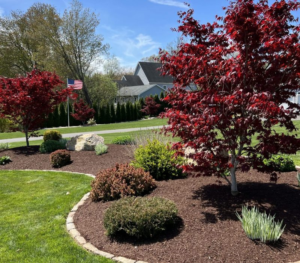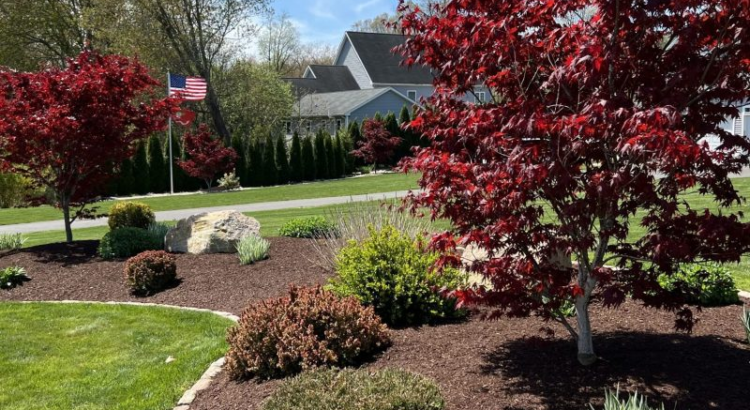Landscaping adds curb appeal and increases the value of your property. It also offers many other long-term benefits.
Studies have shown that walking through a landscaped environment has health benefits, including lower stress levels. A well-designed and maintained landscape provides an escape you can enjoy with friends and family. Click https://vantaoutdoors.com/ to learn more.

When designing a landscape, a landscape architect considers three-dimensional space’s aesthetic and functional aspects. This includes spatial definition, transitions between different landscape planes, and how a landscape relates to the home or building. This helps to ensure a landscape meets the client’s expectations and makes it possible to add elements or make changes later without disrupting the property’s overall look.
The first step in a landscape layout is to create a base map, which can be done on paper or with an online or downloadable application. This map should show the property boundaries and the existing architectural features of the house and yard, such as fences, walls, or other hardscape. Then, draw a series of circles or blobs (bubble diagrams) on the base map to represent how you want to use your landscape. For example, you might include bubbles for screening the view of your neighbor’s yard, pathways, new flower beds, and even a kids’ play area. Don’t worry about the cost of these ideas at this stage; this is just a brainstorming exercise.
Once the bubble diagrams are drawn, a landscape designer can determine which geometry best suits the site and existing architecture. The geometric layout can be rectilinear, curvilinear, radial, or a combination of these designs. Regardless of the chosen geometry, all landscape elements must be related to one another and are on the right scale. For example, a pathway to the front door should be level one, wide enough for two people (41/2- to 5-feet wide). Paths connecting to this main path should then scale down to level two (21/2- to 3-feet wide), and so on.
The plants incorporated into a landscape provide visual impact, texture, and color and fulfill various functional roles. They can create horizontal and vertical dimensions and transitions, form focal points, and provide structure and screening. They can add seasonal impact through the foliage, bloom, twig architecture, and fragrance. They can also contribute to the health of a local ecosystem.
Proper plant selection and placement is the heart of landscaping. It helps establish a sustainable landscape that will reduce the need for irrigation water, fertilizer, and herbicides and decrease energy consumption from lighting and air conditioning. It is also important to consider the construction materials used for hardscape elements and how they relate to the surrounding natural environment. Avoid using creosote-impregnated railroad ties and lumber treated with chromated copper arsenate, which can leach into the soil.
Trees and shrubs should be planted at the correct depth to ensure a strong root system and promote a healthy plant. They should also be well-spaced to grow properly and not compete for resources. Too many trees crowded into too small of an area can damage the trunks and roots, encircling them as they try to find moisture and nutrients in a limited space.
Simple lines and curves often characterize good design. The lines can create real or imaginary spaces that draw the eye through a landscape. Repetition, symmetry, and proportion also contribute to the overall design integrity.
Most of the time, people think of landscapes when they hear the word “landscaping.” However, it is critical to include hardscape elements, such as walls, patios, outdoor lighting, and walkways, in the landscape planning. A well-planned paved surface or fence will help define a landscape, provide a functional outdoor living space, and increase the home’s curb appeal. It is also important to consider the materials chosen for these hardscape elements and how they will complement the home’s architectural style and blend with the surrounding landscape. Careful attention to these design aspects can result in a beautiful and functional landscape lasting for years.
A beautiful landscape is complete with well-placed lighting. Landscape lighting shows off your hard work in the evening and allows you to enjoy your property after the sun goes down. It also allows guests and visitors to navigate your landscape safely.
A landscape lighting system is a great investment that will add value to your home. A good landscaper will help you choose the right fixtures for your property and budget, whether a few lights to light up walkways or a full-fledged lighting system to showcase the beauty of a water feature or garden. They can even create a plan to illuminate seasonal plants, so they shine brightly during the right season.
When choosing your fixture color, it is important to think about how you will use the lighting. For example, a warm white fixture is better for uplighting trees and plantings because it looks more natural. A cool white fixture, on the other hand, works better for highlighting architectural features because it casts a sharper beam.
The lighting should be positioned to highlight the best parts of your landscaping without paying too much attention to the fixtures themselves. This will ensure that the lights look natural, not like they steal the show.
Pathway lighting is a popular option to show off your pathways and gardens at night. It can also highlight outdoor dining areas, fountains, and other property features.
You can also add accent lighting to highlight specific plants and create a focal point. This is ideal for a specimen tree or to draw attention to a unique or colorful part of your landscaping.
Another benefit of accent lighting is highlighting a vertical element of your landscaping, such as a fence or stone wall. Aiming two or more lights at a particular element will reduce the harsh shadows that a single light can create and help to give your landscaping a sense of depth.
When you walk through a neighborhood beautifully lit with lights on the trees or around a fountain, you are instantly inspired to walk through the area and admire your surroundings. The same can be said for commercial spaces that are illuminated well to encourage customers to linger, spend time shopping, and enjoy the scenery.
The maintenance of a landscape is a crucial aspect of the overall design. It typically includes lawn care, gardening, and general yard upkeep. It also involves weeding, pruning, and snow removal. Many homeowners hire a landscaping company to perform the tasks necessary to maintain their properties. A quality landscaping service will help them choose plants, trees, and shrubs that are appropriate for the climate and property and provide ongoing care for their landscape.
Regular landscape inspections help to identify potential problems. These inspections include examining irrigation systems, inspecting tree health and structure, and monitoring soil and grass conditions. The homeowner or a professional can perform these inspections. In addition, the inspections can be used to make changes or updates to the landscaping.
Landscaping is an investment in the beauty and value of a home or commercial property. When properly maintained, it can help increase a property’s value and improve its utility.
It is important to remember that the time and care required for a landscaping project will vary throughout the year. The maintenance schedule will depend on the season and the weather. Some tasks may be done only in warm weather, while others must be completed in cooler seasons. Creating a maintenance schedule can help keep track of the tasks that must be performed.
It is a good time to plant new plants or overseed cool-season grasses in the fall. It is also a good time to mulch garden and landscape beds, ensuring a uniform two to three-inch layer. It is also a good time to inspect the condition of climbing plants and tie them to their stakes, trellises, or other supports. Insect and disease problems can be identified and treated now, and preventative treatments can be applied to minimize the likelihood of recurring problems.
It is also a good time to clean out water features, such as fountains and ponds. It is a good idea to fertilize container gardens and landscape beds with a water-soluble fertilizer. This can help to promote growth and improve color throughout the season.




